#berlin's bronx
Text
With 580 acres of ex-airport real estate now available, the area is being dreamed of as a sustainable neighborhood of wide open green spaces, bike lanes, and affordable efficient housing.
After old Tegel Airport in Berlin was closed down in favor of a new, more modern one, workers started clearing the ground for the Schumacher Quartier, a project that has been brewing since 2017, and which seeks to address car pollution, housing shortages, and many other modern urban issues.
Schumacher Quartier will provide upwards of 5,000 homes for more than 10,000 people, together with the corresponding amenities such as schools, daycare centers, shopping facilities, and lots of greenery. A further 4,000 homes are planned for the neighboring districts.
The charter for the design incorporates the desires of housing for everyone, urban green space and public areas, an open educational landscape, climate-friendly and water-sensitive urban development, guaranteed environmentally-friendly mobility, and participation from the community members.
#Tegel Airport#berlin#Schumacher Quartier#Utah#Kuwait#Taichung#The Bronx#nature#energy saving#architecture#construction#oh brave new world
2 notes
·
View notes
Text
THIS DAY IN GAY HISTORY
based on: The White Crane Institute's 'Gay Wisdom', Gay Birthdays, Gay For Today, Famous GLBT, glbt-Gay Encylopedia, Today in Gay History, Wikipedia, and more … December 11


1475 – Pope Leo X (d.1521), born Giovanni di Lorenzo de' Medici, was the Pope from 1513 to his death in 1521. He was the last non-priest (only a deacon) to be elected Pope. He is known for granting indulgences for those who donated to reconstruct St. Peter's Basilica and his challenging of Martin Luther's 95 Theses. He was the second son of Lorenzo de' Medici, the most famous ruler of the Florentine Republic, and Clarice Orsini. His cousin, Giulio di Giuliano de' Medici, would later succeed him as Pope Clement VII (1523-34).
Several modern historians have concluded that Leo was homosexual. Contemporary tracts and accounts such as that of Francesco Guicciardini have been found to allude to active same-sex relations - alleging Count Ludovico Rangone and Galeotto Malatesta were among his lovers.
Cesare Falconi has examined in particular Leo's infatuation with the Venetian noble Marcantonio Flaminio, with Leo arranging the best education that could be offered for the time. Von Pastor has argued, however, against the credibility of these testimonies, and rejected accusations of immorality as anti-papal polemic. Gucciardini was not resident at the papal court during Leo's pontificate, while other contemporaries such as Matteo Herculano took pains to praise his chastity. Paul Strathern, a British writer and academic, argues that Leo, while homosexual, was not sexually active as pope, despite identifying notable members of that family as such.

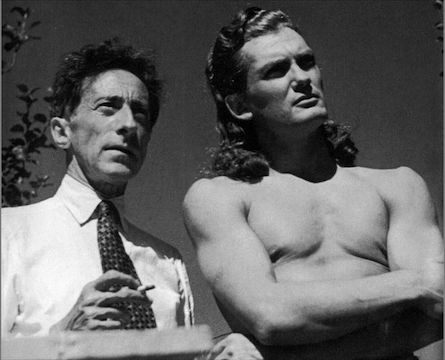
Jean Cocteau and Jean Marais
1913 – Jean Marais, French actor (d.1998); Marais was never much of an actor, and it is doubtful he would have achieved international fame had he not become Jean Cocteau's lover, but he was, by universal acclaim, one of the most handsome men ever to appear in films. In the 1940s when he made most of his movies for Cocteau, actors were still slicking down their hair with Kreml and Vitalis. But he changed all that. His cheveaux fous and athletic good looks created a new style of postwar leading man.

When in 1946 he spent his time in Cocteau's Beauty and the Beast, trapped within an ape-like constume, waiting for Beauty's kiss to turn him once again into Jean Marais, Gay moviegoers around the world secretly wished that they were Josette Day who actually got to kiss the handsome actor's furry face. What is perhaps most interesting about the friendship between Cocteau and Marais is that the actor's face in profile bore an astonishing resemblance to the boys Cocteau had been sketching for thirty years before meeting him.
In the 1960s, he played the famed villain of the Fantômas trilogy. After 1970, Marais's on-screen performances became few and far between, as he preferred concentrating on his stage work. He kept performing on stage until his eighties, also working as a sculptor. In 1985, he was the head of the jury at the 35th Berlin International Film Festival.


1948 – Alvin Baltrop (d.2004) was a gay African-American photographer who earned fame through his photographs of the Hudson River piers during the 1970s and 1980s.
Baltrop was born in 1948 in the Bronx. He discovered his love of photography in junior high school. Baltrop received no formal art education; older photographers from the neighborhood taught him different techniques and how to develop photos himself.
Baltrop enlisted in the Navy as a medic during the Vietnam War and continued taking photos, mainly of his friends in sexually provocative poses. He built his own developing lab in the sick bay, using medic trays for developing trays. After his time in the Navy, Baltrop worked odd jobs as a street vendor, a jewelry designer, a printer, and a cab driver. Because he wanted to spend more time taking photos at the Hudson River piers, he quit his job as a cab driver to become a self-employed mover. He would park his van at the piers for days at a time, living out of his van to take pictures.
From 1975 through 1986, Baltrop took photographs of the West Side piers, where he was a well-known member of the community. Baltrop knew every person he photographed, and people often volunteered to be photographed. Younger boys and men at the piers often confided in him about their sexual orientation, their relationships with their families, their housing status, and their work.
Baltrop captured the gay cruising spots and hookup culture that existed in New York City before the AIDS epidemic. Baltrop's photographs not only captured human personalities, but also the aesthetics of the dilapidated piers. His life work is a snapshot of gay, African-American, and New York City history.
Baltrop struggled to make his way in the art world, facing racism from the white gay art world. Gay curators often rejected his work, accused him of stealing it, or stole his work themselves.

"Three Sailors"
Late during the 1990s, NYC artist John Drury, who knew Alvin from their shared neighborhood - Drury living on Third Street, with his wife and Baltrop on Second Street, in lower Manhattan - befriended the artist and recognized the photographers unique abilities, nominating him for a Louis Comfort Tiffany Foundation Award for the Arts. Alvin Baltrop had few exhibits in his lifetime; his work gaining international fame only after his death.
According to one journalist, Baltrop came out as gay at fourteen years old. Baltrop had long term relationships with men and women, but preferred identifying as gay.
Baltrop was diagnosed with cancer in the 1990s. Impoverished and without health insurance, curators and filmmakers attempted to exploit him for their own financial gain. He died on February 1, 2004

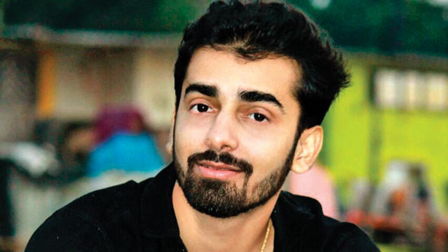
1990 – Nakshatra Bagwe, born in Mumbai, India, is an Indian actor and award winning film maker. Nakshatra will be making his Indian feature film debut in My Son is Gay and is due for his international film debut as the lead actor of Hearts. His films Logging Out, Book of Love, Curtains and PR (Public Relations) represent the current LGBT scenario of India.
He is a LGBT rights activist and also an organiser of Gujarat's first ever pride march. Nakshatra has participated in several Pride Parades in India. He won KASHISH – Mumbai International Queer Film Festival in 2012 for his debut film Logging Out. It was screened at prestigious venues like Queens Museum of Arts (New York), The Old Cinema (London) and it was also a part of Queer India European tour 2012 to raise awareness about LGBT issues in the Indian context.
Nakshatra hails from Konkan coastal region. Masure, Malvan is his native village. He takes part in homosexuality awareness projects. Nakshatra and his mother were featured in a promo of popular Indian television show Satyamev Jayte. He came out to society when he participated in Asia’s first LGBT flashmob. He also participated in second queer flashmob which happened at Dadar station, Mumbai. Nakshatra posed nude for a campaign named 'Breaking Closets'.
In July 2014, He became the brand ambassador of Moovz, a global social network for gay men. Nakshatra is first and only openly Indian LGBT person to be signed up as the brand ambassador by any brand till now.

1998 – The mother of Tyra Hunter (1970 – 1995) is awarded $2.9 million in a wrongful death lawsuit against the city of Washington DC. Hunter, a pre-operative transsexual, died of injuries sustained in a car accident in 1995. Emergency medical technicians at the scene were abusive and withheld treatment, and a doctor at DC General Hospital failed to follow nationally accepted standards of care.


18 notes
·
View notes
Text
"In the case of car culture, the problems of sprawl and automobile dependency did not inevitably result from the automobile itself, but from the power interests that redesigned society around it. The problem was created by subsidies to monoculture development, freeways systems imposed by eminent domain, and legal prohibitions — like zoning — against mixed-use development.
Before the rise of car culture and car-centered urban design, the norm was the compact, mixed-use city or town where residences were within foot, bicycle, bus or streetcar distance of the downtown district where people worked or shopped. Increased population was accommodated primarily by modular proliferation — e.g. the railroad suburb — rather than outward sprawl.
Absent the imposition of car culture by the federal and local governments and by the local real estate industry, the automobile would have served a useful niche function in cities laid out in the old fashion. Its primary market would have been people like farmers in the areas outside cities, where population concentrations were insufficient to be served by streetcar or rail lines. For periodic trips into town and back, perhaps in a small truck capable of conveying a load of vegetables to the farmers’ market or bringing home groceries and dry goods, a light internal combustion engine or electric motor would have been sufficient. With no need for rapid acceleration on the freeway, there would be no point for heavy engine blocks with six cylinders, and the overall weight of the vehicle could be reduced accordingly. With flat body panels capable of being produced on a cutting table, there would have been no need for Detroit’s two- or three-story stamping presses. The automobile industry would have been an affair of hundreds of local factories.
Hence it is not true that “[p]ast a certain threshold of energy consumption, the transportation industry dictates the configuration of social space.” Rather, the configuration of social space dictates the forms of transportation adopted, which dictates the level of energy consumption.
Illich’s tendency to see the proliferation of managerial bureaucracies and their unwilling clienteles as an expansionary phenomenon in its own right with no need for a causal explanation, rather than a secondary effect of larger class and power interests, is also illustrated in his treatment of squatters.
Both the non-modernized and the post-modern oppose society’s ban on spatial self-assertion, and will have to reckon with the police intervening against the nuisance they create. They will be branded as intruders, illegal occupants, anarchists and nuisances, depending on the circumstance under which they assert their liberty to dwell: as Indians who break in and settle on fallow land in Lima; as favellados in Rio de Janeiro, who return to squat on the hillside from which they have just been driven — after 40 years’ occupancy — by the police; as students who dare to convert ruins in Berlin’s Kreuzberg into their dwelling; as Puerto Ricans who force their way back into the walled-up and burnt buildings of the South Bronx. They will all be removed, not so much because of the damage they do to the owner of the site, or because they threaten the health or peace of their neighbors, but because of the challenge to the social axiom that defines a citizen as a unit in need of a standard garage. [emphasis added]
Both the Indian tribe that moves down from the Andes into the suburbs of Lima and the Chicago neighborhood council that unplugs itself from the city housing authority challenge the now-prevalent model of the citizen as homo castrensis, billeted man.
Illich’s framing of this as some inherent expansionary logic or hegemonic drive inherent in the “managerial-professional classes” themselves, and not the outcome of a much larger, long-term process of land privatization and enclosure driven by capitalist class interests, is a major critical failure."
-Kevin Carson, ”The Thought of Ivan Illich: A Libertarian Analysis“
22 notes
·
View notes
Text
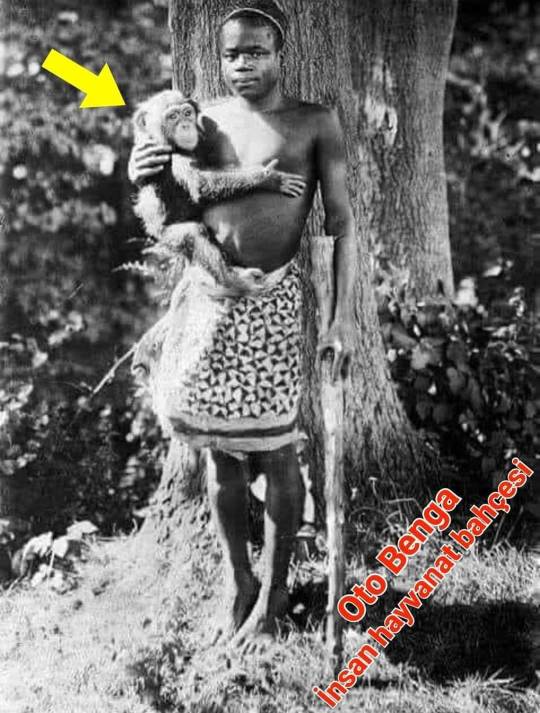
O bir Afrikalı’ydı,
Kongo'lu bir gençti.
Boyu 1.49,
46 kiloydu..
23 yaşında, evli, bir çocukluydu.
Güler yüzlü, hayat dolu bir insandı.
Adı Oto Benga’ydı..
Kendi dilinde manasi “Dost” demekti.
Bir gün nehirde balık avlarken yakaladılar onu. Yakalayan Amerikalı Samuel P. Verner’di. Boynundan ve ayaklarından zincire vuruldu. Yük taşısın diye sadece ellerini özgür bıraktılar.
Kırbaçlar altında saatlerce yol yürüttüler. Sonra onlarca soydaşıyla birlikte bir geminin makina bölümüne konuldu. Zifiri karanlıkta, haftalar süren bir yolculuk sonrası New York’ta gün ışığıyla buluştu. Soydaşlarından ayırıp bir kafese koydular kendisini. Bir depoya hapsettiler. Günlerce orada tutuldu. Hergün önüne bir kuru somun attılar. Tarih 9 Eylül 1906’ydı.
Oto Benga, Amerika kıtasına ayak basan ve adına 'insan' dedikleri bu mahlukun bu kadar gaddar, bu kadar acımasız, bu kadar zalim olduğunu bilmiyordu. Onun vatanında aslanlar, aç timsahlar ve yırtıcı hayvanlar bile bu derece vahşi değildi.
New York Bronx Hayvanat Bahçesi’nde o gün görülmemiş bir kalabalık vardı. Hayvanat Bahçesi hasılat rekoru kırıyordu. Nedeni New York Times Gazetesi’nde çıkan bir haberdi. Şöyle yazıyordu. “Vahşi adam Bronx’da maymunlarla aynı kafesi paylaşıyor. İnsanın ilk ataları ile bir arada. Bakıcısı bazen serbest bırakıyor. Eylül ayı boyunca akşamüstleri ziyaret edilebilir.”Gazete haberine bir de not eklemişti. “Bazı kesimler bu olaya tepki gösterse de, bilim adamları Benga’nın insan olarak değerlendirilemeyeceği kanaatindedir."
Oto Benga’yı önce hortumla yıkadılar. Sonra hayvanat bahçesinde içinde ağaçlar olan geniş bir kafesin içine koydular. Kucağına Dohong adlı yavru orangutanı verdiler. Gazeteciler fotoğraflarını çekerken, binlerce insan merakla kendisini izledi. Oto Benga da onları. Yüzünde garip bir ifade vardı. Hüzün ve kin. Yavru orangutan korkudan sımsıkı ona sarılmıştı..
Hergün saatlerce poz verdiler. Bir hafta içinde ziyaret edenlerin sayısı 250 bini geçti. Bazıları kafese kemik atıyordu. Oto Benga sinirlenip, sivri dişlerini gösterince, “Cannibal, cannibal” (Yamyam yamyam) diye tempo tutuyorlardı. Gazeteler “Benga bir yamyamdır” diye yazıyordu.
Oto Benga’ya yapılan bu zulme, çoğu Hıristiyan olan New York halkından kimse ses çıkarmadı. Ne politikacılar, ne bilim adamları, ne gazeteciler, ne aydınlar. Yüreklerin kulakları sağırdı. Bronx Hayvanat Bahçesi Oto Benga’yı serbest bıraktı. Pantalon, ceket giydirdiler. Ayak işlerinde çalıştırdılar. Tarih 20 Mart 1916 idi..
Eşinden, çocuğundan, soydaşlarından binlerce kilometre uzakla olan Oto Benga, çaldığı bir silahla kendisini kalbinden vurarak intihar etti. Çünkü ölüm onun için özgürlüktü. Öldüğünde henüz 32 yaşındaydı. Bronx Hayvanat Bahçesi zamanla Oto Benga ile ilgili tüm kayıtları sildi. Ancak gazete haberleri ve fotoğraflar gerçeği gizleyemiyordu. Hayvanat Bahçesi yetkilileri, tepkiler artınca “Dünyanın her yerinde yapılıyor, biz niye yapmayalım?” dediler..
Söyledikleri doğruydu. O yıllarda uygar medeni denilen Avrupa’nın bir çok yerinde aynı vahşet sergileniyordu, Londra, Paris, Berlin, Brüksel, Stuttgard, Barcelona, Milan, Hamburg gibi metropollerde kafes içinde Afrikadan kaçırılan insanlar sergileniyoru, diğer insanların eğlencesiydi. Bu vahşet öylesine bir gelir kapısı olmuştu ki, “Hayvanat Bahçeleri”nin yerini, “İnsan Bahçeleri” almıştı. 1960’lara kadar binlerce insan kafeslerde hayvanlar gibi sergilendi. Çığlıkları yeri, göğü inletti. Ama modern insanlar. kör ve sağırdı..
Bugün dünyaya ÇAĞDAŞLIK, MEDENİYET ve İNSAN HAKLARI NUTUKLARI ATAN ALÇAKLAR, DÜN İNSANLARI KÖLE DİYE SATANLARIN, BUGÜN PETROL İÇİN IRAK ve SURİYELİLERİN ÜZERİNE BOMBA YAĞDIRANLARIN TA KENDİLERİ...
Mehmet Akif ne güzel demiş,"MEDENİYET DEDİĞİN TEK DİŞİ KALMIŞ CANAVAR"
Batılılar bugünkü Şatafatlı hayatı sömürdükleri mazlumların kanlarına, ALTIN ve ELMAS madenlerini çalıp açlıktan öldürdükleri, KÖLE YAPIP sattıkları AFRİKALI ÇOCUKLARA BORÇLULAR...
Alıntı
İyiki cehhennem var ve zalimler için yaşasın cehennem...
Gökhan Karaman
...........
He was an African,
He was a young man from Congo.
His height is 1.49,
It was 46 kilos.
He was 23 years old, married, with one child.
He was a smiling and lively person.
His name was Oto Benga.
In his native language, it meant "Friend".
One day they caught him fishing in the river. The catcher was the American Samuel P. Verner. He was chained around his neck and feet. They just left their hands free to carry the load.
They walked for hours under the whips. Then he was put in the engine compartment of a ship with dozens of his kinsmen. After weeks of travel in total darkness, he met the light of day in New York. They separated him from his kin and put him in a cage. They were imprisoned in a warehouse. He was held there for days. They threw a dry loaf in front of him every day. The date was September 9, 1906.
Oto Benga did not know that this creature that set foot on the American continent and called 'human' was so cruel, so cruel, so cruel. In his homeland, even lions, hungry crocodiles, and predators were not so wild.
There was an unprecedented crowd that day at the New York Bronx Zoo. The Zoo was breaking records. The reason was an article in the New York Times Newspaper. It read like this. “The wild man shares a cage with the monkeys in the Bronx. together with the first ancestors of man. The caregiver sometimes lets it loose. It can be visited in the afternoons throughout September.” He added a note to the newspaper article. "Although some groups reacted to this event, scientists are of the opinion that Benga cannot be considered as a human."
They first washed Oto Benga with a hose. Then they put them in a large cage with trees in the zoo. They gave him a baby orangutan named Dohong. Thousands of people watched him curiously as the journalists took their pictures. Oto Benga also has them. He had a strange expression on his face. Sadness and hatred. The baby orangutan hugged him tightly in fear.
They posed for hours every day. Within a week, the number of visitors exceeded 250 thousand. Some were throwing bones into the cage. When Oto Benga got angry and showed his fangs, they were chanting "Cannibal, cannibal" (Cannibal cannibal). “Benga is a cannibal,” the newspapers wrote.
The people of New York, most of whom are Christians, did not speak out against this persecution of Oto Benga. Neither politicians, nor scientists, nor journalists, nor intellectuals. Hearts were deaf. The Bronx Zoo has released Auto Benga. They wore pants and jackets. They did legwork. The date was March 20, 1916.
Oto Benga, who was thousands of kilometers away from his wife, children and relatives, committed suicide by shooting himself in the heart with a stolen gun. Because death was freedom for him. He was only 32 when he died. Over time, the Bronx Zoo deleted all records related to Auto Benga. But newspaper reports and photographs could not hide the truth. When the reactions increased, the zoo officials said, "It is done all over the world, why shouldn't we do it?" they said..
What they said was true. In those years, the same brutality was exhibited in many parts of Europe, which was called civilized, in metropolitan cities such as London, Paris, Berlin, Brussels, Stuttgard, Barcelona, Milan, Hamburg, people smuggled out of Africa in cages were exhibited, it was other people's entertainment. This brutality became such a source of income that the "Zoos" were replaced by "Human Gardens". Until the 1960s, thousands of people were displayed as animals in cages. His screams made the sky and earth groan. But modern people. was blind and deaf.
Today, the scoundrels who are lecturing the world on CONTEMPORARY, CIVILIZATION and HUMAN RIGHTS, THEY ARE THEY THINGS WHO SELL PEOPLE AS SLAVE IN THE YEARS, AND TODAY TAKE A BOM ON IRAQ AND SYRIANS FOR OIL FOR OIL...
How well Mehmet Akif said, "CIVILIZATION IS THE ONE TOO LEFT MONSTER"
Westerners owe today's pompous life to the blood of the oppressed, to the blood of the oppressed, to the AFRICAN CHILDREN they stole the GOLD and DIAMOND mines, killed them with hunger, made them slaves and sold them...
Quotation
Good thing there is hell and long live hell for the oppressors...
Gokhan Karaman
17 notes
·
View notes
Text
Konmari day 17: komono
This is so much easier than paper, guys. And I'm still not sure why I wasn't allowed to start with it.
This bitch ugly. Yeet!
I'm a little bit miffed that because paper was so hard I have not really got where I wanted to be with the komono when another group of people comes to do work in my house tomorrow. Maybe being forced through a hard category was somehow good for me but if her reason for this is that paper is an easier category for everyone, I have to say, respectfully: Marie-san, that is not true. I thought your point was not to stall the tidying process. I do agree with the sentimental items last advice wholeheartedly, though. I wonder how that's going to feel.
As for komono: I know, capitalism, sigh, but it should be more normal to rent things. Things that you can return to a designated place if indeed, it turns out you do not use them much.
Stores want to make it so that everything you buy is a split second decision. And it shouldn't have to be. There should be an actual fault margin and no harm done. Or you bake a cake once a year and so you only need it in april. You know how you live. A library for high quality goods. That makes it much easier to try something out, returning it is fine since you know where to go with it, no guilt when it turned out to be not for you after all, and so much less waste. Renting now has a sense of poverty about it, as if you're too poor to afford your own, but this isn't Victorian Britain, nobody cares how much stuff you have. And I know that would take away from "beautiful stuff as a status symbol" but we're humans, we'll find another thing, and in the meantime, stuff you own will be stuff that is tried and tested to make your life better.
You also won't have to resort to poor quality items when you decide to try something out.
(I was watching A Bronx Tale a lot the past days and at a certain point a teenager laments: "We don't even own a car!" Colagero, you live in New York, you ass. Friends of mine who've stayed in Berlin don't own a car either. You don't need a car, you know that! You want to be fancy you rent a car, that's how people have lived for centuries. The subway stop is a five minute walk, and cabs exist.
Dumbass).
What I love about taking the superfluous away is that it truly can reveal the beauty and keeps doing that. This Christmas, my mother decided to offer my father's banjo to my cousin (his nephew, his sister's son). None of us play the banjo, and he plays guitar. But the banjo is so intrinsically linked to my father that I just couldn't stand it. I hoped my sister would veto, but she was more than fine. I wasn't, but what are you going to do? Get over yourself, that's what.
So my cousin has the banjo and I have pretended to have nO prOBleM aT AlL with it, ahem.
Sorting through my things, I came upon a collection of my father's silver miniatures. Which was emotional enough in intself because they represented all his passions: a vespa, a volkswagen beetle, student emblems and...
A miniature banjo I had never before noticed.
Gosh darn it, Papa!
They aint getting that ❤
10 notes
·
View notes
Photo
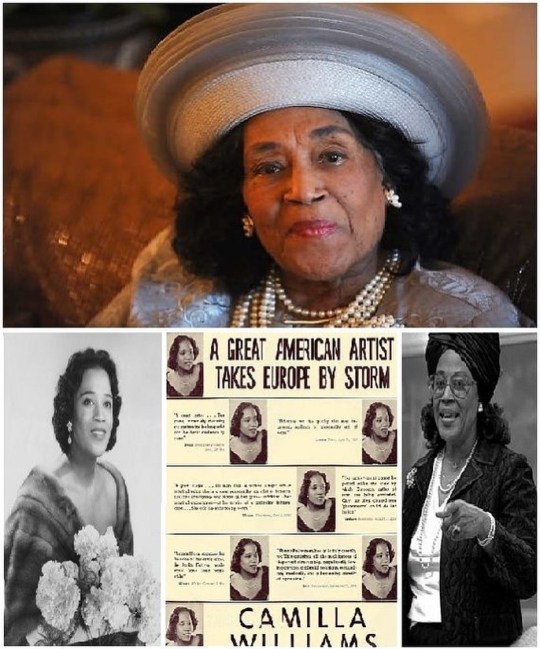
Camilla Ella Williams (October 18, 1919 – January 29, 2012) was an operatic soprano who performed nationally and internationally. After studying with renowned teachers in New York City, she was the first African American to receive a regular contract with a major American opera company, the New York City Opera in the title role of Madama Butterfly. She had won honors in vocal competitions and the Marian Anderson Fellowship. She became the first African American to sing a major role with the Vienna State Opera. She performed as a soloist with numerous European orchestras. She toured throughout the US as well as Asia, Australia, and New Zealand. She was the first African American appointed as a Professor of Voice at Indiana University. She became the first African-American instructor at the Central Conservatory of Music in Beijing. She became a Professor Emerita of Voice at Indiana University Jacobs School of Music but continued to teach privately. She trained at Virginia State College and received her BA in music education. She left her job as a teacher to study music in Philadelphia with a prestigious voice instructor, Marion Szekely Freschl. She performed on the coast-to-coast RCA radio network. During her time at the New York City Opera, she performed Nedda in Pagliacci, Mimi in La bohème, Marguerite in Faust, Micaela in Carmen, and the title role in Aida. She sang Bess in the landmark, the first complete recording of Porgy and Besa. As part of the civil rights March on Washington for Jobs and Freedom, she sang "The Star-Spangled Banner" at the White House and she sang the anthem before 250,000 people at the Lincoln Memorial. She was a soloist with the Royal Philharmonic, BBC Symphony, Berlin Philharmonic, Vienna Symphony, Chicago Symphony, Philadelphia Orchestra, and the New York Philharmonic. She recorded Symphony No. 8 with Stokowski and the New York Philharmonic. She taught voice at many places, including Brooklyn College, Bronx College, Queens College, Talent Unlimited, and Danville Museum of Fine Arts. #africanhistory365 #africanexcellence https://www.instagram.com/p/Cj2giwMr4dP/?igshid=NGJjMDIxMWI=
2 notes
·
View notes
Text
HILDA CASSIDY
1931

Hilda Cassidy is a play in three acts by William Jordan Rapp, Henry Lieferant and Sylvia Lieferant.
In January 1931, producer A.H. Woods announced he had acquired the play and would star Pauline Lord. Fay Bainter was also mentioned for the lead. By the end of January, the title role was cast with Katherine Alexander. William Harrigan (son of Ned Harrigan of Harrigan and Hart) would co-star. Woods was still unsure if he would bring the play to Broadway soon - or hold it till next season.
The play takes place in the yard of a tenement on 3rd Avenue in New York City (Act I); the backroom of Tom Cassidy's Cigar Store (Act II); the Cassidy living-room (Act III).
Hilda Cassidy is the long-suffering wife of a loutish husband. He gets involved in bootlegging and goes to prison. When he comes out, he finds his now-grown daughter is to marry a man just like he used to be. Hilda, on the other hand, enables them to elope.
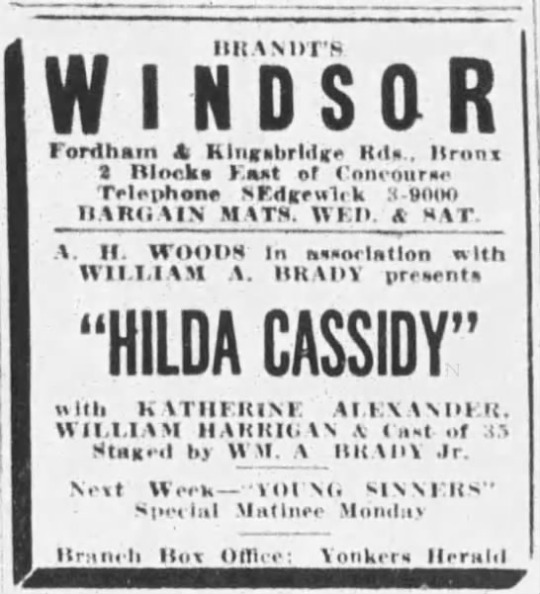
On February 17, 1931, the world premiere of Hilda Cassidy took place on the Subway Circuit at Brandt’s Windsor Theatre in Bronx NY. William A. Brady Jr. (son of the famous producer) staged the play.

Since the characters age of the course of the three acts, it was decided to rehearse a second, younger cast for Act Two, just in case the actors playing the characters were unconvincing as their younger selves.
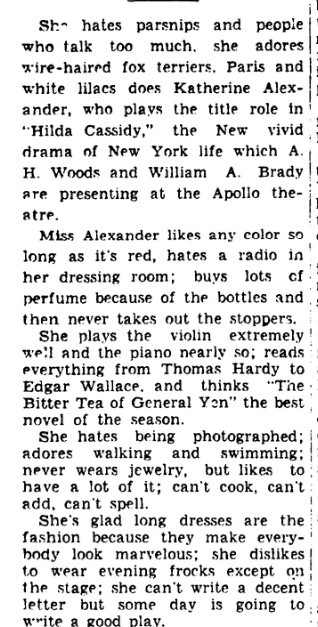
The leading lady was profiled in the papers, listing her ‘likes’ and ‘dislikes’. Sounds like a very particular woman!
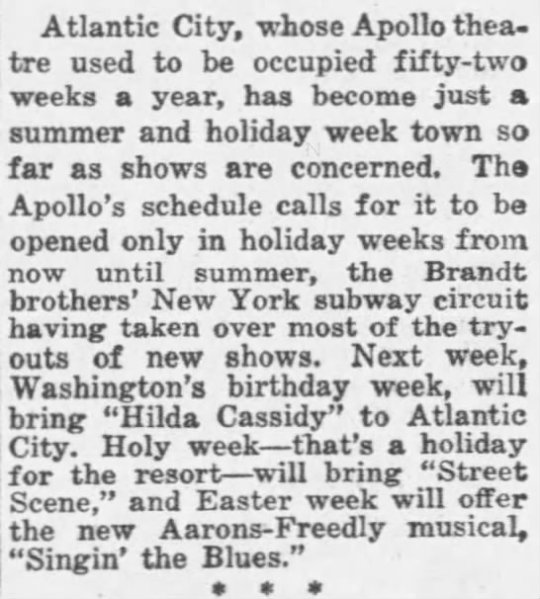
During the first two decades of the 20th century, Atlantic City was a hub of theatrical activity. But by 1931, only one theatre was presenting live legit theatre, and then only on a part-time basis. Atlantic City’s play incubator status had been usurped by the Subway Circuit.

Despite this, the play left the Bronx for Atlantic City, doing a week at Nixon’s Apollo Theatre on the Boardwalk opening February 23rd. Surely Broadway was next...

But that was not the case, as was reported as early as the beginning of 1931, producer Woods closed the play. His announced intent was to save it for the following season.

The play basically disappeared for two years. When it finally resurfaced, much had changed. One of the writers, William Jourdan Rapp, requested his name be taken off the play. The new production would be backed by Harold Stone and Bernard Kaplan, but they withdrew at the last minute, turning producing chores over to Robert Stephens Inc. The leading role would be played by Stella Adler, on loan from the Group Theatre. The Broadway production was to open on April 26th at the Martin Beck Theatre (now the Al Hirschfeld).
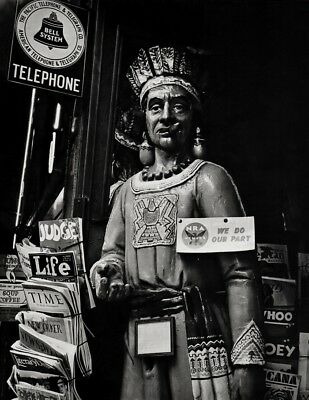
Just before the play started rehearsals, producers were unable to cast one key character: a wooden cigar store Indian. The second act takes place in a family-run cigar store, and what self-respecting tobacconist didn’t have a wooden Indian out front? Famed photographer Ansel Adams took the above photo in 1933, the same year the play was staged.

In addition to the missing wooden Indian, the set involved a turntable. Just as it had in the Bronx, the technical requirements of the play caused a slight delay in opening.

When it finally arrived, the opening night party was a Who's Who of music: Mrs. Irving Berlin, Wanda Toscaninl, Ira and George Gershwin, and Jascha Heifetz. The party was short-lived when the reviews came out.
“Hilda Cassidy is played by Stella Adler, a fine actress who is wholly unsuited to the demands of this part. She seems to have had good deal of trouble with her lines last night, but it was probably due to many last-minute changes In the script.” ~ ROWLAND FIELD
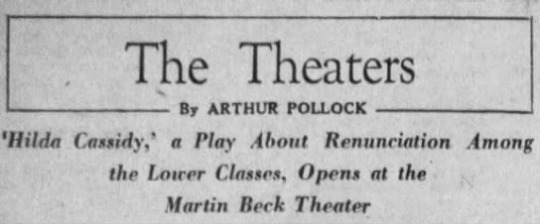
“It is far from being a play which will make history, and there are better shows in town.” ~ ALVIN J. KATTON
By Monday morning, May 7, 1933, Hilda Cassidy was gone after just 4 performances on Broadway.
#Hilda Cassidy#Stella Adler#Atlantic City#Nixon's Apollo Theatre#1931#Broadway#Broadway Play#Martin Beck Theatre#Al Hirschfeld Theatre#Subway Circuit#Cigar Store Indian#Theatre#Stage
2 notes
·
View notes
Text
Hustensaft Jüngling erklärt, wie Hip Hop die Musikindustrie verändert hat

In der sich ständig weiterentwickelnden Landschaft der Musikindustrie hatten nur wenige Genres einen so tiefgreifenden Einfluss wie Hip Hop. Hustensaft Jüngling, eine Koryphäe der Hip-Hop-Szene, bietet einzigartige Einblicke in die transformative Reise dieses Genres und seinen beispiellosen Einfluss auf die Musikindustrie. Von seinen bescheidenen Anfängen in der Bronx bis zu seiner weltweiten Dominanz hat Hip Hop nicht nur musikalische Normen neu definiert, sondern auch die Struktur der Branche geprägt.
Sampling und Beatmaking
Eines der markantesten Merkmale des Hip-Hop ist der innovative Einsatz von Sampling. Hustensaft Jüngling betont, wie Hip-Hop-Künstler sich von verschiedenen Genres, darunter Funk, Jazz und Soul, inspirieren ließen, um einzigartige und vielseitige Beats zu kreieren. Dieser Ansatz brachte nicht nur vergessenen Klassikern neues Leben ein, sondern stellte auch konventionelle Vorstellungen von Originalität in der Musikproduktion in Frage.
Der Aufstieg des MC
Das Herzstück des Hip Hop ist die Kunst des MCing – das lyrische Können von Rappern, die Worte als Waffen einsetzen. Hustensaft Jüngling weist darauf hin, dass sich Hip-Hop durch seine Betonung des Geschichtenerzählens und des sozialen Kommentars von anderen Genres unterscheidet. Das Genre wurde zu einer Plattform für Künstler, auf der sie ihre Erfahrungen, Kämpfe und Wünsche zum Ausdruck bringen konnten, und fand damit bei Zuhörern auf der ganzen Welt Anklang.
Barrieren abbauen
Der Aufstieg des Hip-Hop zur Berühmtheit stellte eine Herausforderung für die vorwiegend rocklastige Musikindustrie dar. Hustensaft Jüngling erklärt, wie Hip-Hop-Künstler mit gesellschaftlichen Normen konfrontiert wurden und Themen wie Rasse, Ungleichheit, Armut und Polizeibrutalität in den Vordergrund rückten. Mit zunehmender Akzeptanz im Mainstream entwickelte sich Hip-Hop zu einem wirkungsvollen Instrument für gesellschaftliche Veränderungen, das geografische und kulturelle Grenzen überschritt.
Wirtschaftliche Stärkung
Der Einfluss von Hip Hop auf die Musikindustrie geht über den künstlerischen Ausdruck hinaus. Hustensaft Jüngling beleuchtet, wie Hip-Hop-Künstler zu Unternehmern wurden und die Wirtschaftslandschaft der Branche veränderte. Von Modelinien bis hin zu Getränkewerbung nutzten diese Künstler ihre Marke, um ihre Einnahmequellen zu diversifizieren, sich finanziell zu stärken und zukünftige Generationen zu inspirieren.
Technologische Fortschritte
Das digitale Zeitalter spielt eine entscheidende Rolle auf der transformativen Reise des Hip-Hop. Hustensaft Jüngling weist darauf hin, wie das Internet den Zugang zu Musik demokratisierte und es unabhängigen Künstlern ermöglichte, ein globales Publikum zu erreichen, ohne dass traditionelle Plattenlabels erforderlich waren. Social-Media-Plattformen wurden für Künstler von entscheidender Bedeutung, um ihre Marke aufzubauen, mit Fans in Kontakt zu treten und ihre Arbeit zu bewerben, was zu einer weiteren Dezentralisierung der Branche führte.
Globale Herrschaft
Der globale Einfluss des Hip Hop ist unbestreitbar und Hustensaft Jüngling unterstreicht seine Fähigkeit, sprachliche und kulturelle Barrieren zu überwinden. Von Tokio bis Berlin ist Hip Hop zu einer universellen Ausdruckssprache geworden. Der Einfluss des Genres zeigt sich nicht nur in der Musik, sondern auch in der Mode, Kunst und Jugendkultur weltweit.
Abschluss
Wie Hustensaft Jüngling eloquent erklärt, ist der Wandel der Musikindustrie durch Hip Hop ein Beweis für seine Widerstandsfähigkeit, Authentizität und kulturelle Relevanz. Von seinen bescheidenen Anfängen in der Bronx bis zu seiner globalen Vorherrschaft hat Hip Hop die Art und Weise verändert, wie wir Musik wahrnehmen und konsumieren. Während wir die Entwicklung des Genres weiter verfolgen, bleibt eines klar: Die transformative Kraft des Hip Hop ist grenzenlos und hinterlässt in der Musikindustrie für kommende Generationen einen unauslöschlichen Eindruck.
0 notes
Text
🎨🙅🏿♀️#ArtIsAWeapon #NewExhibit
One of my favorite artists, Bronx-native @iamdiannesmithart, pays homage to #HipHop and its birthplace The Boogie Down with her new exhibit
DIANNE SMITH: TWO TURNTABLES & A MICROPHONE, on view July 7 - August 20, 2023 at The Bronx Museum of the Arts
📍1040 Grand Concourse, Bronx, NY 10456

VIA bronxmuseum.org: "One two, one two…Party people in the place to be…Let me hear you say, hey, ho…
When you hear these lyrics at a hip-hop party you know it’s about to be a good time filled with music, dancing, joy, and community. Dianne Smith’s exhibition Two Turntables & a Microphone celebrates Black joy and expressions of identity that hip-hop has fostered through its community-building power. Hip-hop parties during the 1970s, created with virtually nothing more than two turntables and a microphone, have played a large role in the lives of Bronx youth, especially in the early days of hip-hop. Through these gatherings Bronx-native Smith, like many others, found a space filled with creativity, freedom, hope, and love. With this year marking the 50th anniversary of hip-hop, Smith celebrates this milestone by paying homage to hip-hop’s Bronx roots and its role in empowering communities across the world through a large-scale and site-specific interdisciplinary installation.
Smith mines memories of her personal experiences in hip-hop culture from hanging out and partying with the Kango Crew to documenting the graffiti adorned building of the Kunsthaus Tacheles in Berlin, Germany to her Fulbright in Guayaquil, Ecuador. These cherished memories are then fused with visual and auditory elements from an array of sources that form a universal narrative of how hip-hop has created a positive environment for its global audience.
This project invites visitors to offer their experiences—in the form of art, text, and personal keepsakes which becomes part of the exhibition—as we reflect upon the communal and creative elements of hip-hop and #theBronx.
Curated by #Souleo @souleouniverse"
Image: Dianne Smith, Two Turntables and a Microphone, 2023. Digital collage with archival photo by @HenryChalfant.
#DianneSmith #ForTheCulture #BlackGirlArtGeeks
#Dianne Smith#Bronx Museum#New Exhibit#Hip Hop#The Bronx#The Boogie Down#BlackArtists#BlackGirlArtGeeks
0 notes
Text
The Art of Photography, photobooks
youtube
Ted Forbe has a youtube account called The Art of Photography where he reviews photobooks and explains how effectively constructed they were through a theme, repeating pattern or layout. I don't have experience with creating a photobook so his videos help me gain an idea of what could my book look like.
My favourite of the books he presented was India, a photographic essay by Shhourya Ray. The layout and photos complement each other well, featuring portraits, candid shots, and magnum contact sheets. I liked how Shourya Ray employed portraits to capture his subjects, and I was curious to see how he laid out his photographs. Demonstrating how photos can be powerful on their own or as pair and how I could showcase my book's concept without always having two photo pages next to each other. This prompted me to inspect my photographs, selecting them based on connecting and building my concept on its own and as part of a series.

youtube
In the video Storytelling with Photography, Ted Forbe showcased more photobooks. He explained how "From the Bronx to Berlin and Beyond worked well to tell an amazing narrative. He stated it felt like a movie and "if you look at this collection of photographs, there's really nothing extraneous. Everything belongs to the project, and I think that's really important; it gives it clarity and unity. It's very well-paced as you go throughout the book."This quote helped me to understand what I wanted people to feel and see when they looked at my photographs.
I want viewers to feel like they were there on the day I took the images, bringing the energy to life as you flip through the pages. Due to this, I stepped back from my draft photobook and ask Does this image communicate my concept well? Is it necessary to crop and zoom in to highlight the laughter? Do these photographs complement each other in the layout? Are they capable of standing on their own? Is this image necessary, or do I like it?
0 notes
Photo


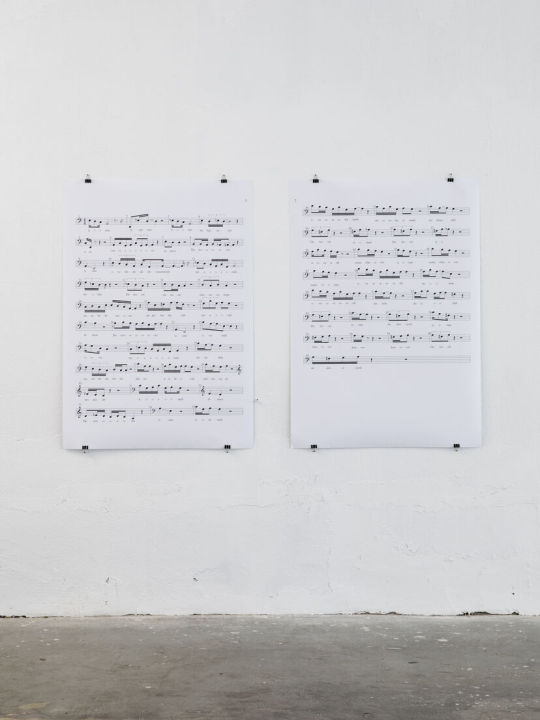
Steffani Jemison & Justin Hicks (Mikrokosmos)
Another time, this time, one time
24 Jun – 2 Jul 2022
CCA Berlin – Center for Contemporary Arts
Formed in 2016 as the collaborative platform of composer Justin Hicks and artist Steffani Jemison, Mikrokosmos mines the history of Black music. This ongoing project has manifested in many forms: workshop, study session, concert, listening session, book, prompt, score. The exhibition at CCA Berlin presents two related compositions inspired by Gil Scott-Heron’s ambitious songbook. Another time, this time, one time (Aaliyah, Barbara, Brandy, Chaka, David, Erykah, Gil, Lionel, Loleatta, Mariah, Marvin, Stevie) tracks a small group of melismatic* gestures across bodies and time; it is a search for the "mother run." Another time, this time, one time, the first Mikrokosmos LP, uses Gil Scott-Heron and Brian Jackson’s “We Almost Lost Detroit” (1977) as the raw material for R&B songwriting. Like a game in which new words are formed from existing letters, these live compositions and recompositions take the form of musical studies, samples, and improvisations. Jemison and Hicks reflect upon a wide range of subjects, including Scott-Heron’s biography, police violence in the United States, and the nuclear catastrophe that threatened the city of Detroit in 1966.
*Melisma (Greek: lit. 'song'; from melos, 'song, melody') is the singing of a single syllable of text while moving between several different notes in succession. Music sung in this style is referred to as melismatic. An informal term for melisma is a vocal run.
Justin Hicks is a multidisciplinary artist and performer who uses music and sound to investigate themes of presence, identity, and value. His work has been featured at Lincoln Center for the Performing Arts, Performance Space New York, The Public Theater, JACK, National Black Theatre, The Bushwick Starr, MoMA, Dixon Place, festival Steirischer Herbst (Graz, Austria), Western Front Society (Vancouver, BC), MASS MoCA, The Whitney Museum of American Art, Nottingham Contemporary (Nottingham, UK), The Albertinum - SKD (Dresden, DE), The Highline, and The John F. Kennedy Center for Performing Arts among others. Hicks has collaborated with notable visual artists, musicians, and theater-makers including Abigail DeVille, Charlotte Brathwaite, Kaneza Schaal, Meshell Ndegeocello, Cauleen Smith, Helga Davis, and Ayesha Jordan. He was the Drama Desk-nominated composer for Mlima’s Tale by Lynn Nottage (The Public Theater 2018 dir. Jo Bonney). His practice with artist Steffani Jemison, Mikrokosmos, has deployed commissioned performances and exhibitions internationally. Hicks was a member of Kara Walker’s 6-8 Months Space and holds a culinary diploma from ICE in New York City. He was born in Cincinnati, OH, and is based in the Bronx, NY.
Steffani Jemison was born in Berkeley, California and raised in Cincinnati, Ohio. Her work has been the subject of solo exhibitions and special projects at JOAN Los Angeles (2022), Contemporary Art Center Cincinnati (2021), the Everson Museum (2021), the Stedelijk Museum (2019), Nottingham Contemporary (2018), Jeu de Paume and CAPC Bordeaux (both 2017), MoMA, New York (2015), RISD Museum, Providence (2015), and LAXART, Los Angeles (2013) among others. Her work has been included in numerous group exhibitions, including the Guggenheim Museum (2021), the Whitney Biennial, New York (2019), the Museum of Contemporary Art Chicago (2019), and the Institute of Contemporary Art, Philadelphia (2017). It is in numerous public collections, including the Guggenheim Museum, the Hirshhorn Museum, the Studio Museum in Harlem, the Brooklyn Museum, the Whitney Museum, the Museum of Modern Art, the San Jose Museum of Art, the Albright-Knox Museum, the Stedelijk Museum, and others. Jemison currently lives and works in Brooklyn and is an Associate Professor at Rutgers University Mason Gross School of the Arts.
*Steffani Jemison & Justin Hicks' Another time, this time, one time is part of CCA Berlin's Stirring Up Trouble, a program unfolding until the end of June, and which aims to host, restage, and think alongside four distinct artistic positions that foreground acts of listening and their manifold potentialities. Through their practices, invited artists engage listening as a method of witnessing unseeable formations of violence (Lawrence Abu Hamdan); an invitation to inhabit tropical geographies otherwise (Kent Chan); an everyday practice of place-making and communitarian belonging (Black Obsidian Sound System); and a regenerative archival portal into shared inheritances and histories of struggle (Steffani Jemison and Justin Hicks). By tuning in to organized sounds, accidental leaks, and enforced silences, they conceive modes of aesthetic experience that challenge common perceptions of artmaking, and trace roadmaps to resonant imaginaries.
Stirring Up Trouble is generously supported by the foundation Between Bridges.
Co-conceived with Edwin Nasr.
1 note
·
View note
Text
GVL / Between States of Being

Martha Glenn, Flower, 2021, carved wood, monkey nail, 4 x 6 inches, unique.
Martha Glenn, Sporadic, 2021, motor, moss, bay leaf, 6 x 6 inches, unique.
Between States of Being
Andrew Bailey Arend, Dakota Gearhart, Martha Glenn, and Rachel Meginnes
October 7 - November 19, 2022
Opening Reception: Friday, October 7, 6-9pm
Tiger Strikes Asteroid Greenville (TSA GVL) is excited to present Between States of Being opening October 7 at the TSA GVL gallery. This exhibition, featuring works by Andrew Bailey Arend, Dakota Gearhart, Martha Glenn, and Rachel Meginnes, explores a nebulous space of transformation, where the self is neither what it was before or what it will become. There exists a nothingness between states of being. When something transforms from one thing to another, as with metamorphosis from a caterpillar into a butterfly, there is a time when it is neither the thing it was, nor the thing it will become. But, this space is necessary for metamorphosis, even in the smallest increment. This exhibition is curated by TSA GVL member Lindsay Smith Gustave.
Inspired by Jean-Paul Sartre’s existential text, Being and Nothingness, Between States of Being explores the inevitability of this liminal space as we move between states of being. Our present is a constantly evolving negation of our past, a nothingness that functions purely as a transition from old to new.
These artworks present a conversation that offers different moments in this transformative process: with ceramics, Arend forges the result of alchemical change; Gearhart explores, in video, the nonsensical decay inherent in the metamorphosis into the future self; Glenn envisions the timeless space of waiting in sculptural form; and through reclaimed textiles, Meginnes examines the breaking down of the past self.
Emblematic of a human need to always be in-process, consciously or unconsciously, Between States of Being provides moments for meditation—a pause between past and future. This period of nothingness is a suspension of time for the viewer to reflect on where we were, where we are, and where we might be going.
Andrew Bailey Arend (b. 1987 Anchorage, Alaska) is an artist who explores relationships between body, action, material and ecology. His work generally takes form as sculpture and also touches on performance, drawing and photography. His work is exhibited nationally and he has been awarded residencies and fellowships including Lighthouse Works, The Bemis Center for Contemporary Arts and the Sitka Center for Art and Ecology. Andrew Bailey Arend received his MFA from Alfred University in 2016. He is currently a Lecturer and Lab Operations Assistant Manager for the Art Department at Appalachian State University.
Dakota Gearhart is a transmedia artist whose practice concerns the effects of modern science and technology with a particular focus on the radical deconstruction of contemporary power structures according to an ecofeminist worldview. She seeks to make the familiar strange—and sometimes the strange familiar—and through that inversion, articulate a more robust and less oppressive future. Recent works have explored such topics as the commercial flower trade, gender bias in big tech, and coral reef tourism in her home state of Florida. Color, humor, and a disorienting species of maximalism are common features of her collage-based aesthetic. Her work has exhibited at The Bronx Museum of Art, NY; Tacoma Art Museum, WA; Museum of Fine Arts, St. Petersburg, FL; Disjecta Contemporary Art Center, OR; Horse Hospital, London; Horse and Pony Gallery, Berlin; Lab’Attoir, Thessaloniki, Greece; and Taiyuan University, Taiyuan, China. She has been awarded the BRIC Digital Media Fellowship, Franklin Furnace Fellowship, and a National Endowments for the Arts US-Japan Creative Fellowship which will bring her work to Japan in 2022. She is based in New York City where she teaches Motion Graphics with Parsons School of Design at The New School and with the Integrated Design Media program at New York University.
Martha Glenn is an artist and gallerist living and working in North Carolina. She completed her MFA from Virginia Commonwealth University in 2021, with a BA from the University of North Carolina at Chapel Hill. She previously resided in Berlin, Germany and has exhibited internationally with solo shows at The Anderson (2021, Richmond), The DePillars Gallery (2020, Richmond), State of the Art (2016, Berlin).
Rachel Meginnes is an artist and educator committed to the idea that art creates more fulfilling lives. Rachel received her BA in Art at Earlham College in 1999 and her MFA in Fibers at the University of Washington, Seattle in 2005. In between, she spent two years studying traditional Japanese textile processes in Morioka, Japan. From 2005 – 2011, she co-owned and operated an international rug company based out of Sikkim, India and Seattle, WA. In 2012, Rachel was awarded a three-year residency at Penland School of Crafts in North Carolina which began her shift to making art full-time. Her artwork has been exhibited internationally in Thailand and Hong Kong and can be found in the collections of the Cameron Art Museum, Wilmington, NC; the University of Arkansas, Little Rock, AR; Fidelity Bank, Raleigh, NC; the Capitol Broadcasting Company, Durham, NC; Samsel Architects, Asheville, NC; and in private collections around the country. Rachel has taught all ages and levels from underserved youth in after school programs to college students and adults in the midst of choosing and changing their careers. Her workshops integrating the subjects of art, craft, and design have been offered at craft schools and colleges across the country and in Canada. Rachel has recently developed an arts educational partnership between Earlham College in Richmond, IN and Penland School of Crafts in Penland, NC to promote craft education within the context of academic art. Rachel lives and works in Western North Carolina.
0 notes
Text
KLr news 29.06.22
[#] Happy Saint Peter and Paul! So long we don’t write news. But here we go!
[#] First something unpleasant. We hate to be part of the inflation/speculation party going on, but Deutsche Post increases the cost for shipment of small packages out of EU of 150%, making the cost insane. We decided to increase the cost of tapes from 5 to 6 € in order to put less strain on our non-EU costumers. Hope you all will understand. It is important to pay for music, but we want to be fair.
[#] Our Halfsilks will play Fusion this week end! They will be on stage Thu evening. If you are attending the festival, you can also catch performances by Jana’s band Point No Point and Karen’s band Gym Tonic.
[#] We are happy to announce the release of Earthlogoff second tape, called “Tritium”. It sounds like an earthquake! Be sure to not miss their show in Kopi, Berlin Saturday 09.07.
[#] Two shows scheduled for the Mumbles in the near future: 31.07 at Your Guts Festival in Hamburg and 24.09 at the event Ghost Town Berlin, to revisit independent spaces existing in the city and reviving them for a day. They will play in front of the former Bronx, close to Görli.
[#] Also, we can announce that we are thrilled to release the debut album of Matching Outfits. It is called “Band Made Out Of Sand” and it is truly a pop wonder. The release party will be in Marie Antoinette on 21.09, kick off for their tour in Sweden!
[#] More releases coming up: we will also release the tape version of "El gymnasio en la casa” by Ultrabonus. What we can say, was love at the first sight! Catch them in Ausland at PIA Festival on 07.07 along side of a lot of other great act, also open air!
[#] The Sunday Matinee is alive and kickin, and the next one will be 24.07 in the garden. It is very special for us because it will be the first show of the newly formed The Post Spiderhole Ensemble!
[#] Brabrabra tuns TEN! For the occasion, they are elaborating a very special gala coming up this fall. Stay tune for more.
[#] Other than Matching Outfits and Ultrabonus there are some other releases to be expected this year! First, our very first LP, “Blind Spot” by Adrie, a very beautiful album of indie tunes...and then the tapes of Brabrabra’s drummer Saiko Ruysui as solo, and the tapes of the bands Pieuvre and Vorsicht Kinder.
#pieuvre#vorsicht kinder#adrie#saiko ryusui#ultrabonus#matching outfits#the post spiderhole ensemble#the sunday matinee#Ausland#Ghost town berlin#mumbles#your guts festival#halfsilks#earthlogoff
1 note
·
View note
Text

Der Sommer, die drastischen Rückgänge der Inzidenzzahlen und die zuallermeist milden Omikron-Krankheitsverläufe machen es möglich: Das Bachmann-Lesen 2022 findet wieder live vor Ort in Klagenfurt statt, vom 22. bis 26. Juni. Also auch mit Publikum im ORF-Studio, nachdem letztes Jahr nur die Jury anwesend und 2020 der Wettbewerb komplett digital über die Bühne gegangen war.
Am Dienstagvormittag wurde das Feld der vierzehn Autorinnen und Autoren bekanntgegeben, die nach Klagenfurt reisen und dort lesen werden. Wie jedes Jahr ist der Großteil davon kaum bekannt, da bedarf es genauerer Biografie-Lektüre. Dem Feuilleton, vor allem den Leserinnen und Lesern der „Welt“, ist natürlich der Name Hannes Stein ein Begriff.
Stein schreibt für eben jene Springer-Zeitung, lebt in den USA, „im Stadtteil Riverdale am nördlichen Rand der Bronx“, wie es in seiner Biografie heißt, und ist in den vergangenen Jahren auch als Romanautor hervorgetreten. Ebenfalls nicht ganz unbekannt ist Eva Sichelschmidt. Ihr 2020 veröffentlichter Roman „Bis wieder einer weint“ war für die Longlist des Deutschen Buchpreises nominiert.
Und dann sind da noch der 1994 geborene Elias Hirschl, der in Österreich ein Superstar ist, als Romanautor, Musiker, und Spoken Word-Künstler, sowie Juan S. Guse, der 2012 den Berliner Open Mike gewann und 2019 mit „Miami Punk“ einen fulminanten Cyberpunk Roman veröffentlichte. Behzad Karim-Khani betreibt eine Bar in Kreuzberg
Dann wird es schwieriger, in jedem Fall sehr international bezüglich der Herkunft vieler Autorinnen und Autorinnen: Der in der Lyrikszene gut bekannte und in Berlin lebende Alexandru Bulucz ist mit dabei. Bulucz wurde 1987 im westrumänischen Alba Iulia geboren, wo er bis zu seinem 13. Lebensjahr lebte.
Dann der in der Schweiz lebende Usama Al Shahmani, 1971 in Bagdad geboren. Al Shahmani veröffentlichte in seiner Heimat drei Bücher über arabische Literatur und musste 2002 wegen eines Theaterstückes fliehen.
Der 1977 in Teheran geborenen Behzad Karim-Khani wiederum wuchs im Ruhrgebiet auf, studierte in Bochum Kunstgeschichte und Medienwissenschaft und lebt seit 2012 in Berlin, wo er, so heißt es auf der Bachmannpreis-Website, in Kreuzberg eine Bar betreibt.
Vermutlich liest Karim-Khani eine Passage aus seinem Debütroman „Hund, Wolf, Schakal“, der im August 2022 im Hanser Verlag erscheint. Und nicht zu vergessen: die aus dem slowenischen Murska Sobota stammende und in Österreich lebende Ana Marwan. Man kann also sagen: Es wird interessant. Und, klar, das auch: Der Ingeborg-Bachmann-Preis lebt, er ist unverwüstlich.
Zumal er wieder einmal eine Neuerung parat hält: Die Ermittlung der Preise erfolgt anders. Die Jury vergibt Punkte für die von ihr favorisierten Texte, und zwar von 9 bis 1. Danach wird addiert, und am Sonntag verliest der Justitiar „sukzessive“ die Namen der Preisträger – „beginnend mit dem am niedrigsten dotierten Preis“, von wegen der Spannung. Diesbezüglich langweiliger wird es trotzdem: Es passierte häufiger bei den Abstimmungsrunden, dass ein Autor, eine Autorin ganz nah am Ingeborg-Bachmann-Preis war – und am Ende durchgereicht wurde und ohne Preis von dannen gehen musste.
0 notes
Text
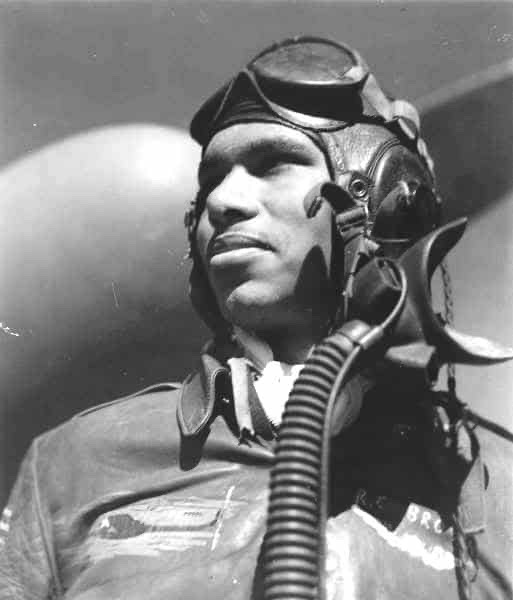
Commander Dr. Roscoe Conkling Brown Jr. (March 9, 1922 – July 2, 2016) was one of the Tuskegee Airmen and a squadron commander of the 100th Fighter Squadron of the 332nd Fighter Group.
He was born in D.C to Roscoe C. Brown Sr. was a dentist and an official in the US Public Health Service. His mother was the former Vivian Kemp, a teacher.
He graduated from Springfield College as valedictorian. He joined the Army, and graduated from the Tuskegee Flight School on March 12, 1944, as a member of class 44-C-SE
He served as a flight leader and operations officer. On a March 24, 1945, mission to Berlin, he shot down a German Me 262 jet fighter, becoming the first 15th Air Force pilot to shoot down a jet. On March 31, he downed a Fw 190 fighter. He was awarded the Distinguished Flying Cross. He was appointed commander in June 1945.
He resumed his education. His doctoral dissertation at New York University was on Exercise Physiology.
He became a professor at New York University and directed the NYU Institute of Afro-American Affairs. He hosted The Soul of Reason. He hosted the Black Arts and CUNY TV show African American Legends. He was President of Bronx Community College and director of the Center for Education Policy at the CINY. He was elected into the National Academy of Kinesiology as an Associate Fellow. He received an honorary doctor of humanities degree from his alma mater, Springfield College.
On March 29, 2007, he attended a ceremony in the Capitol rotunda, where he and the other Tuskegee Airmen were collectively awarded the Congressional Gold Medal.
He was a member and past president of the 100 Black Men of America New York Chapter and a professor of Urban Education at the CUNY Graduate Center. #africanhistory365 #africanexcellence
0 notes
Video
All aboard! Get on over to the App Store and download the @stationhead social radio app! The future of radio is happening now! #music #chatrooms #talk #boston #philly #dmv #brooklyn #manila #bronx #roxbury #uncasville #madrid #paris #berlin #accra #crete #tokyo #honolulu #lasvegas #detroit #chicago #la #nyc #atlanta #orlando (at SunRail) https://www.instagram.com/p/B3elwMxDTzS/?igshid=16r46sxizxsse
#music#chatrooms#talk#boston#philly#dmv#brooklyn#manila#bronx#roxbury#uncasville#madrid#paris#berlin#accra#crete#tokyo#honolulu#lasvegas#detroit#chicago#la#nyc#atlanta#orlando
1 note
·
View note